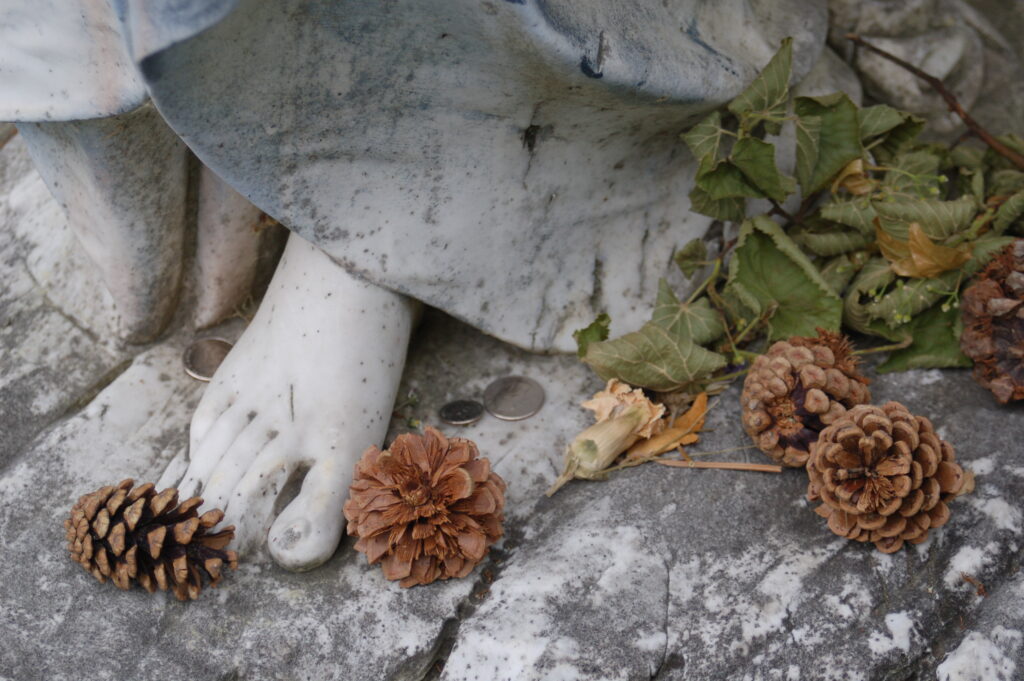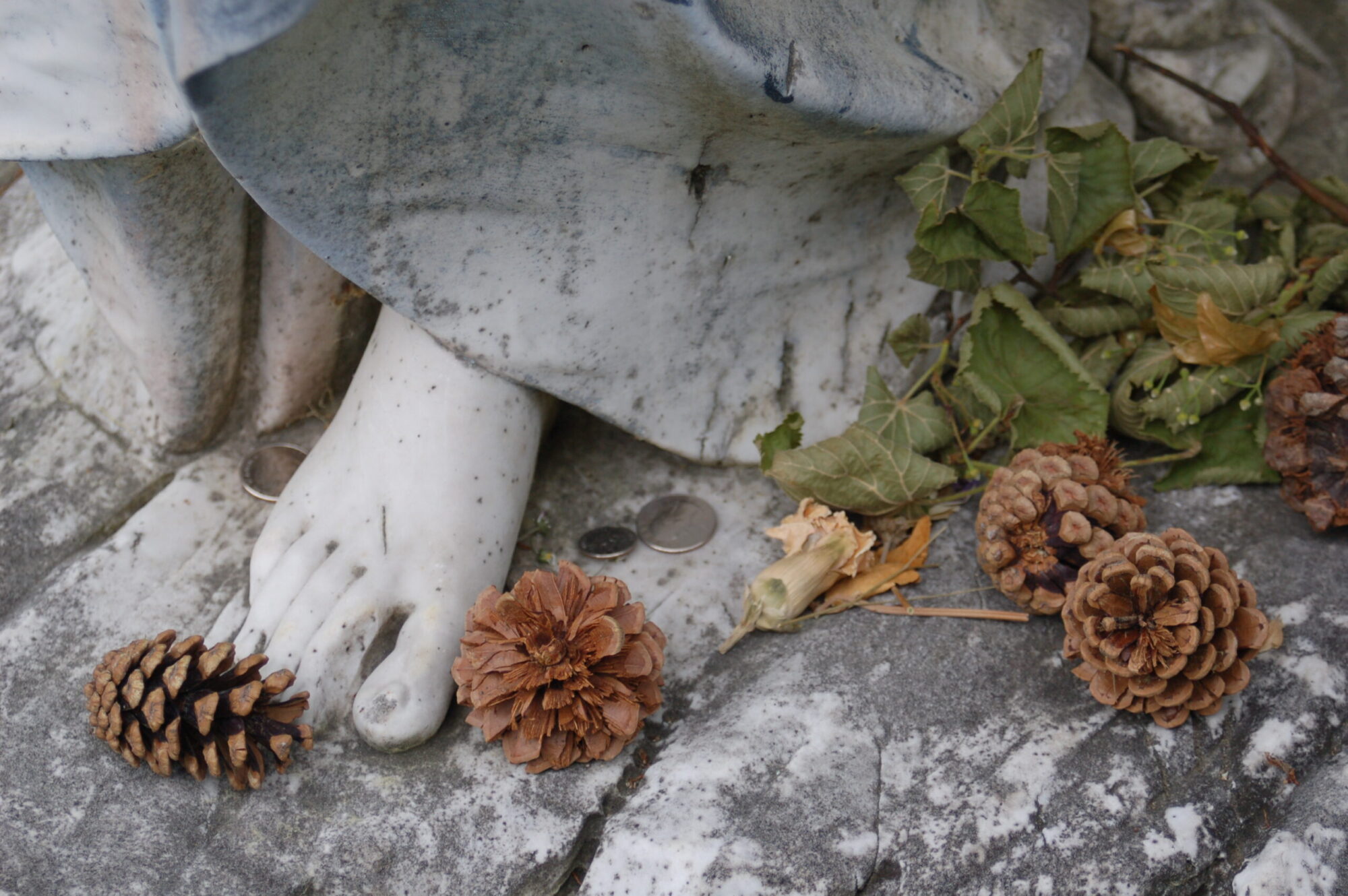1. Visual Analysis
This image, rich in texture and subtle symbolism, captures a serene yet evocative composition of a statue’s foot surrounded by nature’s artifacts—pinecones, dried leaves, and scattered coins. It is a quiet study of time, decay, and reverence.
- Composition: The framing draws immediate focus to the foot, anchoring the scene in a human-like stillness. The surrounding elements—pinecones, coins, and leaves—are positioned naturally, creating balance while hinting at offerings or forgotten moments.
- Light: Soft, natural lighting enhances the gentle details of the marble foot, the weathered texture of the stone, and the earthy tones of the pinecones. Shadows are minimal, adding to the quiet and contemplative mood.
- Color: A muted palette of grays, browns, and greens dominates the image. The pale marble foot contrasts delicately with the warm tones of the pinecones and leaves, creating harmony between the artificial and the organic.
- Texture: The rough, weathered stone contrasts with the smooth, polished surface of the marble foot. The brittle leaves and textured pinecones add organic complexity, enriching the visual story with their tactile qualities.
- Focus and Depth: The image maintains sharp focus on the foot and immediate surrounding objects. This clarity invites the viewer to notice the details—smudges on the marble, veins in the leaves, and the cracks in the stone.
2. Philosophical Reflection
This image serves as a meditation on impermanence, reverence, and the relationship between nature and human-made art.
- Stillness and Life: The marble foot, though lifeless and unmoving, carries the echo of life—a symbolic remnant of human form. Nature’s offerings (pinecones, leaves) remind us of the cyclical nature of life and death, where even decay is beautiful and meaningful.
- Offerings and Time: The presence of coins evokes the idea of offerings, tradition, or remembrance—perhaps a silent tribute to something sacred. They lie alongside nature’s gifts, as though time itself has woven together the human and the natural.
- Wabi-Sabi Aesthetic: The Japanese philosophy of Wabi-Sabi—beauty in imperfection and impermanence—is evident. The marble foot, once pristine, now carries speckles and dirt. The pinecones and leaves, fragile and weathered, remind us of the beauty that emerges in decay.
- Human Presence in Absence: The foot suggests absence. It tells no full story but hints at history—of hands that sculpted it, feet that once walked where offerings now lie, and time that has softened its edges.
This photograph invites contemplation: What remains when we are gone? What does nature offer in our absence, and how does it preserve our memory?
3. Practical Photography Insights
This photograph is an excellent study in capturing texture, storytelling, and mood with simplicity.
- Focus on Details: Close framing allows the foot and surrounding elements to tell a story. Focus on small, overlooked details can often lead to powerful narratives.
- Balance Human and Nature: Combining man-made subjects (statues, architecture) with natural elements (leaves, stones, pinecones) creates depth and contrast, adding visual and thematic richness.
- Lighting for Mood: Soft, diffused lighting works beautifully to maintain an intimate and contemplative mood. Use natural light to highlight subtle textures without introducing harsh shadows.
- Symbolism in Objects: Everyday objects—coins, pinecones—can carry deeper meanings in context. Look for items that might hint at stories of time, memory, or reverence.
Tip: Explore abandoned or aged spaces where human history interacts with nature. Capturing the balance between decay and endurance often leads to compelling images.
4. Reflections
The marble foot stands eternal, unmoving, while nature weaves its quiet tribute around it. Pinecones rest at its side like relics of a forest’s offering; brittle leaves curl like whispers of time, and coins lie scattered, left perhaps by hands seeking solace or connection.
There is reverence here—a silent conversation between life and art, between creation and decay. The smooth marble, carved to mimic life, now carries marks of imperfection, as if time itself has reached out to touch it. And yet, the foot remains. It endures, not untouched but transformed, becoming part of the world it once stood apart from.
The pinecones, the coins, the leaves—they gather like prayers, delicate yet unyielding. They remind us that beauty does not fade but evolves. Even in stillness, there is movement: leaves decay, coins tarnish, and shadows stretch across the stone. And yet, in this quiet, there is no sorrow—only harmony.
Here, life and art coexist. Nature embraces what was made by human hands, turning absence into presence and imperfection into grace. In this moment, we are reminded to pause, to look, and to honor the small offerings time has left behind.

